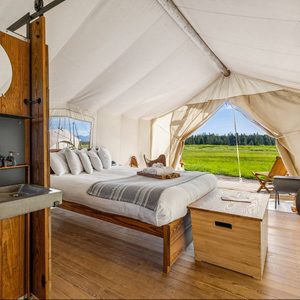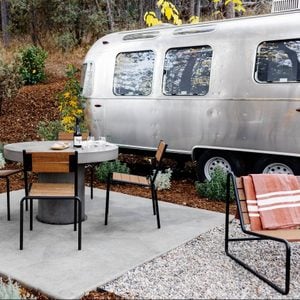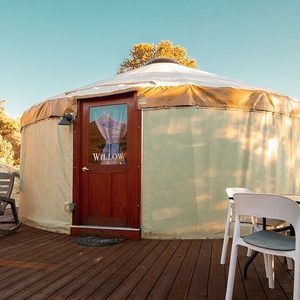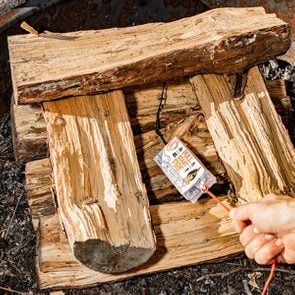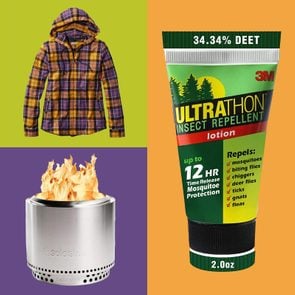A Guide to Glamping—Camping for Those Who Like Comfort as Much as the Great Outdoors
Updated: Feb. 01, 2024

Love the outdoors but also love your creature comforts? Glamping may be the answer.
Our editors and experts handpick every product we feature. We may earn a commission from your purchases.Learn more.
During the pandemic, interest in camping surged and it has remained at record levels, but let’s face it, camping isn’t necessarily for everyone. Granted, camping gets you outdoors and connects you with nature—it’s peaceful, serene and meditative—but frankly, sometimes it’s just not that comfortable. That’s where glamping comes in. What is glamping, exactly? It’s sort of like luxury camping that’s both outdoorsy and also pleasant. Essentially, it’s the best of both worlds, and according to a recent KOA survey, 40% of campers want to take a glamping trip. It’s also ideal camping for beginners.
I’ve gone glamping in a tiny rustic wagon in North Dakota, off-the-grid cabins with wood-fired stoves in New York’s Catskill Mountains, teepees in Utah and Mexico, canvas tents and caves in Jordan, and everywhere in between. It’s been a thrilling experience for me, and my goal is to explain why you should give glamping a shot.
What is glamping?
The glamping definition comes from its status as a portmanteau, a word made by combining the spellings or meanings of two or more words. In this case, the word glamping is a blend of glamorous and camping, implying a more luxe version of traditional camping. However, the meaning of glamping itself is up for interpretation, as there is no single style of glamping experience.
Just like traditional camping, there are a range of glamping experiences, levels of luxury and add-on activities. For instance, glamping could involve a simple safari tent with a basic bed in the desert, or it could be an ultra-glamorous treehouse in the woods. Instead of bringing your own tent, sleeping bag, mattress, blankets and other camping supplies, with glamping, you pretty much just show up and enjoy the experience. Instead of hauling firewood and building a fire, at many glampsites, the fire is already roaring when you arrive, so you can just plop down and enjoy some campfire stories. And, yes, most glamping options offer some form of a bathroom (more on that below).
There are glamping “hotel” chains, such as Under Canvas, which has 12 locations outside of popular national parks around the U.S., as well as independent glamping sites that can be booked through apps like HipCamp and Campspot.
History of glamping
According to the American Glamping Association, an organization dedicated to supporting glamping businesses, the word glamping was first used in the early 2000s in the United Kingdom, when young families were seeking more affordable luxury holiday experiences. Glampsites were popping up across the U.K. and, soon after, the United States and the rest of the world. As early as the 2010s, National Park camping in the United States expanded to include a handful of glamping options.
According to the Oxford English Dictionary (OED), the word glamping was first recorded in The Guardian in 2005, but it wasn’t until 2016 that it was officially added to the dictionary. The current glamping definition in the OED reads: “A form of camping that involves accommodation and facilities more luxurious than those associated with traditional camping.”
Types of glamping
Just like there is a wide range of campsites and camping options, there is also tremendous diversity in terms of glamping setups. Amenities vary dramatically between glampsites, but you can pretty much count on having all the basic necessities like a bed, blankets, sink and toilet. In some very rustic or backcountry settings, the toilet may be outside the tent or tipi, but in most cases, it will be within the structure.
Some glamping accommodations may have a tiny food-prep area and some basic cooking equipment, while others may have elaborate kitchen facilities or on-site restaurants. More luxurious glampsites may even have hot tubs, saunas and power showers. They may also offer activities like hiking, cooking classes and ATV excursions, which may or may not be included in the price. If any particular amenity or activity is important to you, check with the business owner in advance to confirm it’s available.
Below is a list of different types of glamping accommodations, but for further inspiration, check out these luxury camping adventures.
- Yurts: The large tents that originated in Mongolia and Central Asia and were used by nomads are now one of the most common forms of glamping.
- Tents: Unlike thin camping tents, glamping tents tend to be much larger and made from heavier, sturdier fabrics like canvas.
- Tipis/tepees: These Native American–inspired triangular structures tend to be made of canvas and, unlike other forms of glamping, often have bathrooms outside the structure.
- Wagons and shepherd huts: These are some of the most unique glamping options, where rustic covered wagons and wood huts contain little more than a small bed. Bathrooms are usually located outside the wagon.
- Geodesic domes: Futuristic domes can be made of different materials, but they all tend to offer amazing views of nature through large plastic or glass windows.
- Villas and lodges: While luxurious villas and lodges may seem more like traditional bed-and-breakfasts than camping, they tend to be set in stunning natural settings and offer unique access to their surroundings.
- Huts and cottages: This category refers to a range of options that could include a luxurious overwater glamping hut in the Maldives or a basic bungalow along a backwoods river in Vietnam.
- Cabins: Glamping cabins range from rustic and cozy to over-the-top elegance on hard-to-reach mountaintops.
- Cubes and pods: This is another tremendously diverse category and could include an eco-cube outside a Scottish National Park or a pool-equipped jungle pod in Cambodia.
- Airstreams and trailers: Harkening back to the heyday of road-tripping, many glampsites now feature classic Airstreams and trailers that are fully set up and ready to go.
- Barns and farmhouses: Rural options like barns and farmhouses range from classic and quaint to positively palatial.
- Treehouses: As the name implies, treehouse glamping involves accommodations in the trees. In some cases, a structure is built right into and around the trees, but in other cases, it’s more of an elevated lodge surrounded by trees.
- Other unique options: Some glamping options simply don’t fit into any other category because they are so distinct. These might include glamping setups inside an ice cave or an old train car, bus or airplane.
Book your glampsite
Why go glamping?
Glamping options are so varied that this style of holiday can appeal to hardcore campers and hesitant city slickers alike. Personally, I enjoy so-called hardcore camping (which is usually free camping), where you have to hike several miles into the wilderness with a backpack full of supplies and it’s budget-friendly. That said, I also love glamping because I’m more comfortable and have more time to relax. With glamping, I can spend more time enjoying my surroundings instead of setting up and breaking down my tent, building fires, filtering water and the like. I also enjoy just being able to show up in a car with whatever I want, instead of struggling to fit everything I need into a small backpack and worrying that I won’t have room for everything.
If you’re not yet sold on the idea, here are some of the main pros of glamping.
- Less packing: Because so much is provided by the glamping operator, there’s far less to pack, making glamping a more simple and straightforward holiday. One thing you should pack though? These Teva ReEmber camping shoes.
- Running water: While this isn’t guaranteed at every campsite, it’s usually included at most glampsites, though more rustic operations may have the water source just outside your own personal accommodations.
- Warmth: Glamping tents, tipis, yurts and cabins tend to be better insulated than your typical tent, so you won’t have to worry about the cold getting in. Many are also outfitted with wood-burning stoves to keep you extra toasty on chilly nights.
- Real bathrooms: Modern bathrooms with sinks, toilets and showers are available at most glampsites, and in many cases, they’re right within the tent or cabin so you don’t have to leave to do your business.
- A real bed: One of the most challenging aspects of camping is getting a good night’s sleep on a thin sleeping pad or camping mattress. With glamping, you can sleep in a real bed so you wake up fresh for the day’s adventure.
- Waterproof accommodations: Unlike leaky tents, glamping accommodations are typically built to be waterproof (and some are snowproof), so you can stay dry, warm and comfortable inside, regardless of the weather.
Now that you’ve learned about glamping, read on to discover the best RV park and hiking trails in every state.
Sources:
- KOA: “2023 North American Camping & Outdoor Hospitality Report”
- Oxford English Dictionary: “Glamping”



















